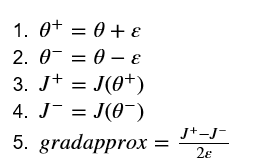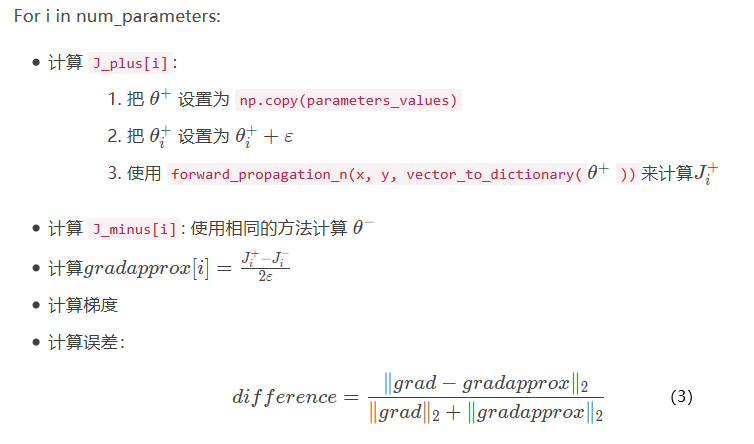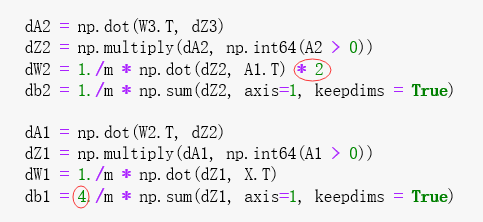Gradient Checking 梯度检查
声明
本文作业是在jupyter notebook上一步一步做的,带有一些过程中查找的资料等(出处已标明)并翻译成了中文,如有错误,欢迎指正!
参考:https://blog.csdn.net/u013733326/article/details/79847918
参考Kulbear 的 【Initialization】和【Regularization】 和 【Gradient Checking】,以及念师的【10. 初始化、正则化、梯度检查实战】,以及何宽 ,
欢迎来到本周的期末作业!在这项作业中,你将学习如何实现和使用渐变检查。
你是一个团队的一员,致力于全球范围内的移动支付,并被要求建立一个深度学习模型来检测欺诈行为——每当有人进行支付时,你都想看看支付是否有欺诈行为,比如用户的账户是否被黑客占领。
但是反向传播的实现相当具有挑战性,有时还存在缺陷。因为这是一个任务关键型应用程序,所以您公司的首席执行官希望确定您的反向传播实现是正确的。你的首席执行官说,“给我一个证据,证明你的反向传播是有效的!”为了保证这一点,您将使用“梯度检查”。
开始吧!
# Packages import numpy as np from testCases import * from gc_utils import sigmoid, relu, dictionary_to_vector, vector_to_dictionary, gradients_to_vector
1) How does gradient checking work? 梯度检查是如何工作的?
反向传播计算梯度 ,其中θ表示模型的参数。使用前向传播和损失函数计算 J,因为前向传播相对容易实现,所以您确信自己是正确的,因此您几乎百分之百确定您正确地计算了成本J。因此,您可以使用计算J的代码来验证用于计算
,其中θ表示模型的参数。使用前向传播和损失函数计算 J,因为前向传播相对容易实现,所以您确信自己是正确的,因此您几乎百分之百确定您正确地计算了成本J。因此,您可以使用计算J的代码来验证用于计算 的代码。
的代码。
让我们回顾一下导数(或梯度)的定义:
如果你不熟悉“limε→0”表示法,那只是表示“当ε真的很小时”
我们知道以下几点:
• 是你想要确保你计算正确的东西。
是你想要确保你计算正确的东西。
•您可以计算J(θ+ε)和J(θ-ε)(在θ是实数的情况下),因为您确信J的实现是正确的。
让我们用等式(1)和一个小的ε值来说服您的CEO,您用于计算 的代码是正确的!
的代码是正确的!
2) 1-dimensional gradient checking 一维梯度检查
考虑一维线性函数J(θ)=θx,该模型仅包含一个实值参数θ,以x为输入。
您将实现计算J(.)及其导数 的代码。然后使用梯度检查来确保J的导数计算是正确的。
的代码。然后使用梯度检查来确保J的导数计算是正确的。
**Figure 1** : **1D linear model** 图一 一维线性模型
上图显示了关键的计算步骤:首先从x开始,然后计算函数J(x)(“前向传播”)。然后计算导数 (“反向传播”)。
(“反向传播”)。
练习:为这个简单函数实现“正向传播”和“反向传播”。一、 在两个不同的函数中计算J(.)(“前向传播”)及其相对于θ的导数(“反向传播”)

1 # GRADED FUNCTION: forward_propagation 2 3 def forward_propagation(x, theta): 4 """ 5 Implement the linear forward propagation (compute J) presented in Figure 1 (J(theta) = theta * x) 6 7 Arguments: 8 x -- a real-valued input 9 theta -- our parameter, a real number as well 10 11 Returns: 12 J -- the value of function J, computed using the formula J(theta) = theta * x 13 """ 14 15 ### START CODE HERE ### (approx. 1 line) 16 J = theta * x 17 ### END CODE HERE ### 18 19 return J
x, theta = 2, 4 J = forward_propagation(x, theta) print ("J = " + str(J))

练习:现在,实现图1中的反向传播步骤(导数计算)。也就是说,计算J(θ)=θx相对于θ的导数。为了省去做微积分,你应该得到dtheta= =x。
=x。

1 # GRADED FUNCTION: backward_propagation 2 3 def backward_propagation(x, theta): 4 """ 5 Computes the derivative of J with respect to theta (see Figure 1). 6 7 Arguments: 8 x -- a real-valued input 9 theta -- our parameter, a real number as well 10 11 Returns: 12 dtheta -- the gradient of the cost with respect to theta 相对于θ的成本梯度 13 """ 14 15 ### START CODE HERE ### (approx. 1 line) 16 dtheta = x 17 ### END CODE HERE ### 18 19 return dtheta
x, theta = 2, 4 dtheta = backward_propagation(x, theta) print ("dtheta = " + str(dtheta))

练习:为了证明反向传播函数正确地计算了梯度 ,让我们实现梯度检查。
,让我们实现梯度检查。
说明:
•首先使用上述公式(1)和较小的ε值计算“gradeapprox”。以下是要遵循的步骤:

•然后使用反向传播计算梯度,并将结果存储在变量“grad”中
•最后,使用以下公式计算“gradeapprow”和“grad”之间的相对差:

计算此公式需要3个步骤:
1、使用np.linalg.norm(...)计算分子
2、计算分母。你需要使用np.linalg.norm(…)两次。
3、把他们相除
•如果这个差异很小(比如小于10-7),您可以非常确信您已经正确地计算了梯度。否则,梯度计算可能会出错。

1 # GRADED FUNCTION: gradient_check 2 3 def gradient_check(x, theta, epsilon = 1e-7): 4 """ 5 Implement the backward propagation presented in Figure 1. 6 7 Arguments: 8 x -- a real-valued input 9 theta -- our parameter, a real number as well 10 epsilon -- tiny shift to the input to compute approximated gradient with formula(1) 11 12 Returns: 13 difference -- difference (2) between the approximated gradient and the backward propagation gradient近似梯度和后向传播梯度之间的差异 14 """ 15 16 # Compute gradapprox using left side of formula (1). epsilon is small enough, you don't need to worry about the limit. 17 ### START CODE HERE ### (approx. 5 lines) 18 thetaplus = theta + epsilon # Step 1 19 thetaminus = theta - epsilon # Step 2 20 J_plus = forward_propagation(x, thetaplus) # Step 3 21 J_minus = forward_propagation(x, thetaminus) # Step 4 22 gradapprox = (J_plus - J_minus) / (2 * epsilon) # Step 5 23 ### END CODE HERE ### 24 25 # Check if gradapprox is close enough to the output of backward_propagation() 检查gradapprox是否足够接近backward_propagation()的输出 26 ### START CODE HERE ### (approx. 1 line) 27 grad = backward_propagation(x, theta) 28 ### END CODE HERE ### 29 30 ### START CODE HERE ### (approx. 1 line) 31 numerator = np.linalg.norm(grad - gradapprox) # Step 1' 32 denominator = np.linalg.norm(grad) + np.linalg.norm(gradapprox) # Step 2' 33 difference = numerator / denominator # Step 3' 34 ### END CODE HERE ### 35 36 if difference < 1e-7: 37 print ("The gradient is correct!") 38 else: 39 print ("The gradient is wrong!") 40 41 return difference
x, theta = 2, 4 difference = gradient_check(x, theta) print("difference = " + str(difference))
结果:

恭喜你,误差小于10-7阈值。因此,您可以有很高的信心,您已经正确地计算了反向传播()中的梯度。
现在,在更一般的情况下,成本函数J有不止一个一维输入。当你训练一个神经网络时,θ实际上由多个矩阵W[l]和偏差b[l]组成!重要的是要知道如何使用高维输入进行梯度检查。开始吧!
3) N-dimensional gradient checking N维梯度检查
下图描述了欺诈检测模型的正向和反向传播。高维参数是怎样计算的呢?我们看一下下图:
**Figure 2** : **deep neural network** 图2 深度神经网络
*LINEAR -> RELU -> LINEAR -> RELU -> LINEAR -> SIGMOID*
让我们来看看您的前向传播和后向传播的实现。
1 def forward_propagation_n(X, Y, parameters): 2 """ 3 Implements the forward propagation (and computes the cost) presented in Figure 3. 4 5 Arguments: 6 X -- training set for m examples 7 Y -- labels for m examples 8 parameters -- python dictionary containing your parameters "W1", "b1", "W2", "b2", "W3", "b3":包含参数“W1”,“b1”,“W2”,“b2”,“W3”,“b3”的python字典: 9 W1 -- weight matrix of shape (5, 4)权重矩阵,维度为(5,4) 10 b1 -- bias vector of shape (5, 1)偏向量,维度为(5,1) 11 W2 -- weight matrix of shape (3, 5) 12 b2 -- bias vector of shape (3, 1) 13 W3 -- weight matrix of shape (1, 3) 14 b3 -- bias vector of shape (1, 1) 15 16 Returns: 17 cost -- the cost function (logistic cost for one example) - 成本函数(logistic) 18 """ 19 20 # retrieve parameters 21 m = X.shape[1] 22 W1 = parameters["W1"] 23 b1 = parameters["b1"] 24 W2 = parameters["W2"] 25 b2 = parameters["b2"] 26 W3 = parameters["W3"] 27 b3 = parameters["b3"] 28 29 # LINEAR -> RELU -> LINEAR -> RELU -> LINEAR -> SIGMOID 30 Z1 = np.dot(W1, X) + b1 31 A1 = relu(Z1) 32 Z2 = np.dot(W2, A1) + b2 33 A2 = relu(Z2) 34 Z3 = np.dot(W3, A2) + b3 35 A3 = sigmoid(Z3) 36 37 # Cost 38 logprobs = np.multiply(-np.log(A3),Y) + np.multiply(-np.log(1 - A3), 1 - Y) 39 cost = 1./m * np.sum(logprobs) 40 41 cache = (Z1, A1, W1, b1, Z2, A2, W2, b2, Z3, A3, W3, b3) 42 43 return cost, cache
现在,运行反向传播。
1 def backward_propagation_n(X, Y, cache): 2 """ 3 Implement the backward propagation presented in figure 2. 4 5 Arguments: 6 X -- input datapoint, of shape (input size, 1) 输入数据点(输入节点数量,1) 7 Y -- true "label"标签 8 cache -- cache output from forward_propagation_n() 来自forward_propagation_n()的cache输出 9 10 Returns: 11 gradients -- A dictionary with the gradients of the cost with respect to each parameter, activation and pre-activation variables. 一个字典,其中包含与每个参数、激活和激活前变量相关的成本梯度。 12 """ 13 14 m = X.shape[1] 15 (Z1, A1, W1, b1, Z2, A2, W2, b2, Z3, A3, W3, b3) = cache 16 17 dZ3 = A3 - Y 18 dW3 = 1./m * np.dot(dZ3, A2.T) 19 db3 = 1./m * np.sum(dZ3, axis=1, keepdims = True) 20 21 dA2 = np.dot(W3.T, dZ3) 22 dZ2 = np.multiply(dA2, np.int64(A2 > 0)) 23 dW2 = 1./m * np.dot(dZ2, A1.T) 24 db2 = 1./m * np.sum(dZ2, axis=1, keepdims = True) 25 26 dA1 = np.dot(W2.T, dZ2) 27 dZ1 = np.multiply(dA1, np.int64(A1 > 0)) 28 dW1 = 1./m * np.dot(dZ1, X.T) 29 db1 = 1./m * np.sum(dZ1, axis=1, keepdims = True) 30 31 gradients = {"dZ3": dZ3, "dW3": dW3, "db3": db3, 32 "dA2": dA2, "dZ2": dZ2, "dW2": dW2, "db2": db2, 33 "dA1": dA1, "dZ1": dZ1, "dW1": dW1, "db1": db1} 34 35 return gradients
您在欺诈检测测试集上获得了一些结果,但您对您的模型没有100%的把握。没有人是完美的!让我们实现梯度检查来验证梯度是否正确。
梯度检查是如何工作的?
如1)和2)中所述,您需要将“gradeapproach”与反向传播计算的梯度进行比较。公式仍然是:
然而,θ不再是标量。这是一本叫做“参数”的字典。我们为您实现了一个函数“dictionary_to_vector()”。它将“parameters”字典转换为一个名为“values”的向量,该向量通过将所有参数(W1、b1、W2、b2、W3、b3)重塑为向量并将它们连接起来而获得。反函数是“向量字典”,它输出“参数”字典。
**Figure 2** : **dictionary_to_vector() and vector_to_dictionary()**
You will need these functions in gradient_check_n()
我们还使用gradients_to_vector()将“gradients”字典转换为向量“grad”。你不用担心这个。
练习:实现梯度检查。
说明:下面是一些伪代码,可以帮助您实现梯度检查。
对于每个i in num_参数:


1 # GRADED FUNCTION: gradient_check_n 2 3 def gradient_check_n(parameters, gradients, X, Y, epsilon = 1e-7): 4 """ 5 Checks if backward_propagation_n computes correctly the gradient of the cost output by forward_propagation_n 6 检查backward_propagation_n是否正确计算forward_propagation_n输出的成本梯度 7 8 Arguments: 9 parameters -- python dictionary containing your parameters "W1", "b1", "W2", "b2", "W3", "b3": parameters - 包含参数“W1”,“b1”,“W2”,“b2”,“W3”,“b3”的python字典: 10 grad -- output of backward_propagation_n, contains gradients of the cost with respect to the parameters.grad_output_propagation_n的输出包含与参数相关的成本梯度。 11 x -- input datapoint, of shape (input size, 1) 12 y -- true "label" 13 epsilon -- tiny shift to the input to compute approximated gradient with formula(1) 计算输入的微小偏移以计算近似梯度 14 15 Returns: 16 difference -- difference (2) between the approximated gradient and the backward propagation gradient 17 """ 18 19 # Set-up variables 设置变量 20 parameters_values, _ = dictionary_to_vector(parameters) #这边keys用不到,可以用“_”代替 21 grad = gradients_to_vector(gradients) 22 num_parameters = parameters_values.shape[0] 23 J_plus = np.zeros((num_parameters, 1)) 24 J_minus = np.zeros((num_parameters, 1)) 25 gradapprox = np.zeros((num_parameters, 1)) 26 27 # Compute gradapprox 28 for i in range(num_parameters): 29 30 # Compute J_plus[i]. Inputs: "parameters_values, epsilon". Output = "J_plus[i]".计算J_plus [i]。输入:“parameters_values,epsilon”。输出=“J_plus [i]” 31 # "_" is used because the function you have to outputs two parameters but we only care about the first one 32 ### START CODE HERE ### (approx. 3 lines) 33 thetaplus = np.copy(parameters_values) # Step 1 34 thetaplus[i][0] = thetaplus[i][0] + epsilon # Step 2 35 J_plus[i], _ = forward_propagation_n(X, Y, vector_to_dictionary(thetaplus)) # Step 3 36 ### END CODE HERE ### 37 38 # Compute J_minus[i]. Inputs: "parameters_values, epsilon". Output = "J_minus[i]". 39 ### START CODE HERE ### (approx. 3 lines) 40 thetaminus = np.copy(parameters_values) # Step 1 41 thetaminus[i][0] = thetaminus[i][0] - epsilon # Step 2 42 J_minus[i], _ = forward_propagation_n(X, Y, vector_to_dictionary(thetaminus)) # Step 3 43 ### END CODE HERE ### 44 45 # Compute gradapprox[i] 46 ### START CODE HERE ### (approx. 1 line) 47 gradapprox[i] = (J_plus[i] - J_minus[i]) / (2. * epsilon) 48 ### END CODE HERE ### 49 50 # Compare gradapprox to backward propagation gradients by computing difference. 51 ### START CODE HERE ### (approx. 1 line) 52 numerator = np.linalg.norm(grad - gradapprox) # Step 1' 53 denominator = np.linalg.norm(grad) + np.linalg.norm(gradapprox) # Step 2' 54 difference = numerator / denominator # Step 3' 55 ### END CODE HERE ### 56 57 if difference > 1e-7: 58 print ("\033[93m" + "There is a mistake in the backward propagation! difference = " + str(difference) + "\033[0m") 59 else: 60 print ("\033[92m" + "Your backward propagation works perfectly fine! difference = " + str(difference) + "\033[0m") 61 62 return difference
X, Y, parameters = gradient_check_n_test_case() cost, cache = forward_propagation_n(X, Y, parameters) gradients = backward_propagation_n(X, Y, cache) difference = gradient_check_n(parameters, gradients, X, Y)

我们给你的反向传播代码似乎有错误!很好,你已经实现了梯度检查。返回反向传播并尝试查找/更正错误(提示:检查dW2和db1)。当你认为你已经修复了梯度检查。请记住,如果修改代码,则需要重新执行定义反向传播的单元格。
你能用梯度检查来证明你的导数计算正确吗?即使作业的这一部分没有评分,我们强烈建议您尝试找到错误并重新运行渐变检查,直到您确信backprop现在已经正确实现。


修改后:

Note:
梯度检查很慢!用 近似梯度计算成本很高。由于这个原因,我们不在训练期间的每次迭代中运行梯度检查。只需几次检查梯度是否正确。
近似梯度计算成本很高。由于这个原因,我们不在训练期间的每次迭代中运行梯度检查。只需几次检查梯度是否正确。
梯度检查,至少我们已经介绍过了,对dropout不起作用。你通常会运行梯度检查算法没有辍学,以确保你的backprop是正确的,然后添加辍学。
恭喜你,你可以相信你的深度学习模型是正确的!你甚至可以用这个来说服你的CEO。:)
**你应该记住这本笔记本**:-梯度检查 验证了 反向传播的梯度 和 梯度的数值近似(使用正向传播计算)之间 的 接近度。
梯度检查很慢,所以我们不是在每次训练迭代中都运行它。您通常只运行它以确保您的代码是正确的,然后关闭它并使用backprop进行实际的学习过程。
